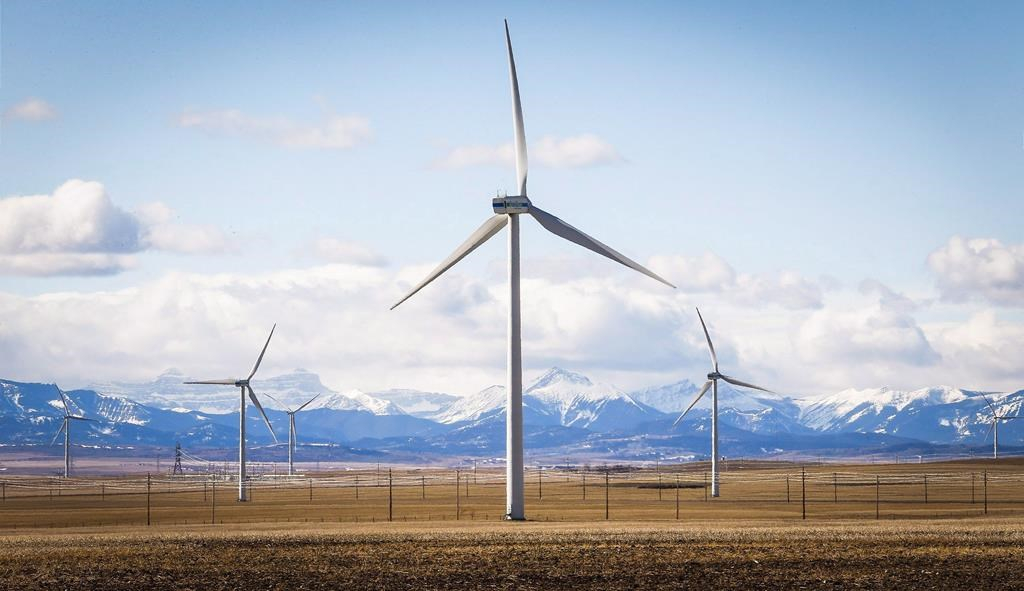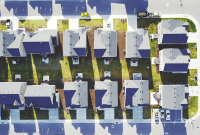Support strong Canadian climate journalism for 2025
Once bitten, twice shy.
It's an old adage that explains why Jason Schneider, the elected reeve of Vulcan County, Alta., is jittery about the renewable energy boom under way in his province.
Like many in rural Alberta, Schneider is still smarting over the way municipalities were left holding the bag when an oil price crash nearly a decade ago resulted in billions of dollars of unfunded liabilities left behind by bankrupt fossil fuel companies.
In Vulcan County alone, the landscape is littered with hundreds of wells with no owners that need to be cleaned up, and the municipality itself is owed more than $9 million in back taxes left unpaid by insolvent oil and gas firms.
So Schneider has a hard time looking at acre upon acre of massive wind turbines or solar panels without fearing a repeat of Alberta's orphan well crisis, or wondering who's going to fix everything if something goes wrong.
"These are large industrial developments, and the reclamation costs are going to be substantial," he said.
"We can see the warning signs, and we are being ignored."
Across rural Alberta, concerns are growing about the long-term implications of the province's renewable energy boom — the speed and scale of which has been nothing short of stunning.
A province that not that long ago was largely reliant on coal for electricity, Alberta is now home to more than 3,800 MW of wind and solar capacity, 1,350 of which came online in just the last 12 months. An additional 1,800 MW of capacity is currently under construction, putting the province on track to meet or exceed the target it set in 2016 to generate 30 per cent of its total electricity from renewable sources by 2030.
In Schneider's Vulcan County, which is home to both the country's largest solar farm and one of Western Canada's largest wind farms, renewable energy developments now account for more than 40 per cent of the local tax base, displacing oil and gas as the number one source of revenue for the local municipal government.
But while many in rural Alberta welcome the economic activity, and farmers and ranchers enjoy the extra income that playing host to solar panels or wind turbines can bring, others are sounding the alarm.
For example, the Rural Municipalities of Alberta recently passed a resolution calling on the provincial government to protect taxpayers from incurring costs associated with the potential decommissioning of renewable energy infrastructure.
Specifically, the association wants to see the government mandate the collection of securities for reclamation from developers before a project goes ahead. That way, municipalities won't be footing the bill if a developer becomes insolvent and walks away.
"What we’ve learned, and what Albertans have learned, is that the cheapest way to get out of reclamation is going bankrupt," said Paul McLauchlin, president of the Rural Municipalities of Alberta.
"Some of these solar installations are being installed by one company, sold to another company ... I talked to a gentleman who’s on his fifth owner, and his solar installation has been there maybe two years. So we’re seeing small companies owning these, and whether they have the wherewithal for reclamation, that’s really what’s driving this conversation.”
In Alberta, the Orphan Well Association is an industry-funded organization tasked with decommissioning old oil and gas infrastructure and returning the land to its prior state. (It's currently backlogged, in spite of a $1 billion funding injection from the federal government in 2020, as well as $335 million in loans from the province.)
But there's no equivalent for the renewable energy industry, though renewable energy companies are required to provide an overview of how they plan to cover decommissioning and reclamation costs before they can receive the go-ahead for their project.
However, for a landowner, entering into a wind or solar lease is entirely voluntary. That's very different from oil and gas, where under Alberta law, property owners are not allowed to refuse companies seeking to develop the fossil fuels that lie under the surface of their land.
Evan Wilson, director of policy and government affairs for the Canadian Renewable Energy Association, said that because solar and wind leases remain private civil contracts between the developer and the landowner, the onus is on the landowner to ensure the inclusion of some kind of provision to mitigate risks associated with the project's end-of-life.
But he added many companies do offer landowners some form of reclamation commitment, either in the form of a letter of credit or bond.
"Landowners do have the ability to veto these projects being built on their land," Wilson said.
"So that puts a lot of pressure on our members to ensure that landowners do feel comfortable with the terms."
Sara Hastings-Simon, an expert in energy, innovation and climate policy at the University of Calgary's School of Public Policy, said it's understandable that municipalities have concerns.
However, she said it's odd that there's a push to enforce new regulations for the renewable sector, when the scope of the orphan well problem shows the oil and gas regulatory system could also use an overhaul.
According to the Alberta Energy Regulator, there are more than 83,000 inactive oil and gas wells in the province currently, and close to 90,000 more that have been sealed and taken out of service, but not yet fully remediated.
A report released last year by the Parliamentary Budget Officer estimated that the cost of orphan well clean-up in Canada will reach $1.1 billion by 2025.
“Obviously we need to make sure that all of our industrial development is done in a way that doesn’t offload costs to the public," Hastings-Simon said.
"But it would make a lot of sense for the province to look at energy development holistically, rather than just picking the one that right now perhaps has more growth.”
This report by The Canadian Press was first published Jan. 29, 2023.




Comments
I dunno, is this a real problem or just something being pushed to blunt momentum? I mean, oil wells are going to get abandoned, because after a while there's no harvestable oil left in that hole in the ground. But solar and wind installations aren't going to run out of sun and wind, so might as well just keep using them. Particularly wind turbines are probably worth just repairing and continuing to use; why would you decommission one and waste all the capital costs when you could just have it generate some more electricity?
And decommissioning is a bigger issue for oil wells when it happens. Abandoned oil wells leave this hole in the ground that weird fumes and stuff come out of; they have to be capped and that's expensive. Solar panels just sit on the ground, and the components are worth something; the issue seems to me more about developing rules and systems for recycling. You could probably get more money back than it costs to cart the stuff away.
Exactly.
My first thought about the potential "abandonment" of solar and wind projects is that it won't come to pass from running out of sunshine and wind. The Pincher Creek Chinooks can blow your hair off and will continue as long as water flows downhill.
Upgrading wind turbines and replacing PV panels with newer and better equipment isn't hard. The turbine masts may eventually have to be demolished but the foundations may be reusable. Even then the epoxy and glass fibre blades and turbine parts are recyclable, and the concrete tower can be crushed and used as aggregate. The key is to develop green cement and continue recycling. Some engineers have already recommended using mass timber as the tower material. Steel scaffolding is 100% recyclable, and posts anchored into the ground to support PV panel arrays can be easily pulled out with backhoes or pile driver cranes.
If a solar or wind energy company goes bankrupt it won't be from the costs of depreciation or replacement, unless the company was slipshod enough to not include these elements as standard line items in their accounting practices. Competition has already driven down the price of producing zero emission electricity in Alberta.
Getting turfed off the land by a farmer at the end of a lease is another story. But that begs the question, What farmer is going to reject the leaseholder revenue? Public agencies run by the feds and provinces have yet to build renewable power projects using wind and solar themselves in a significant way. Given the fast evolving affordable stationary storage technology, it's a matter of time before someone proposes a national smart grid that can easily buy, trade, credit and store power from and to farmers, First Nations and municipalities adjacent to a transmission corridor. Think of it as an energy bank.
The thought that renewables will be abandoned is a non-issue and a distraction from the real problem of dealing with end-of-life oil well abandonment and the failure of both senior governments to prevent industry from socializing the losses and liabilities. That is symbolic of what happens when industry IS the government.